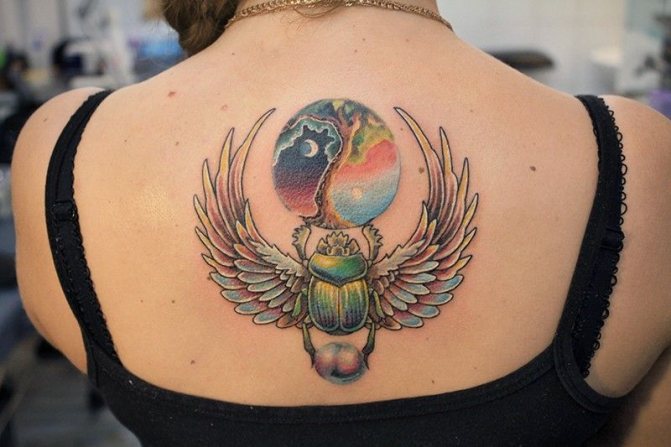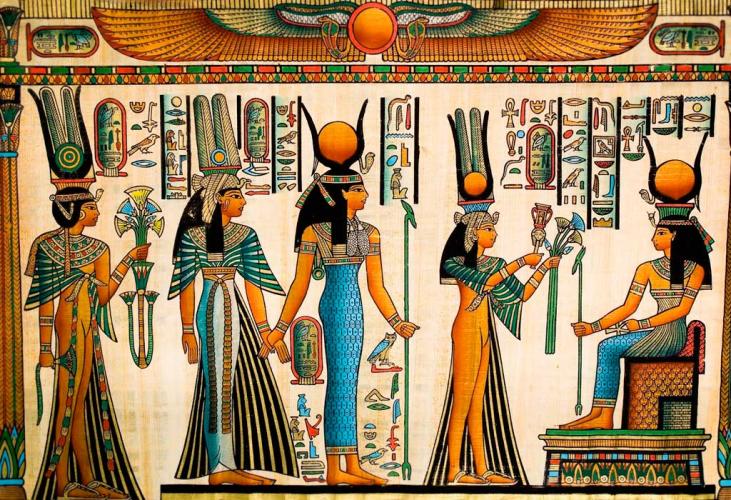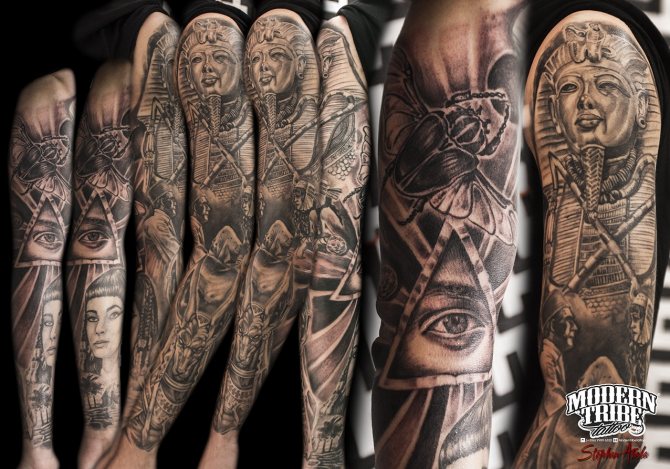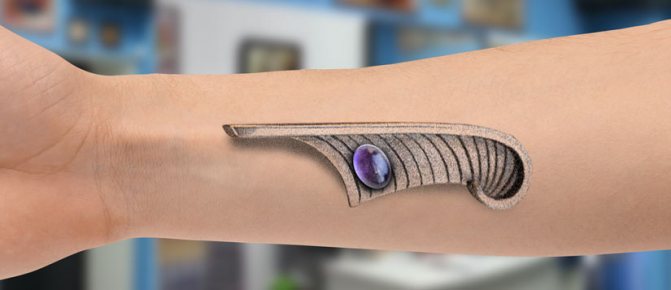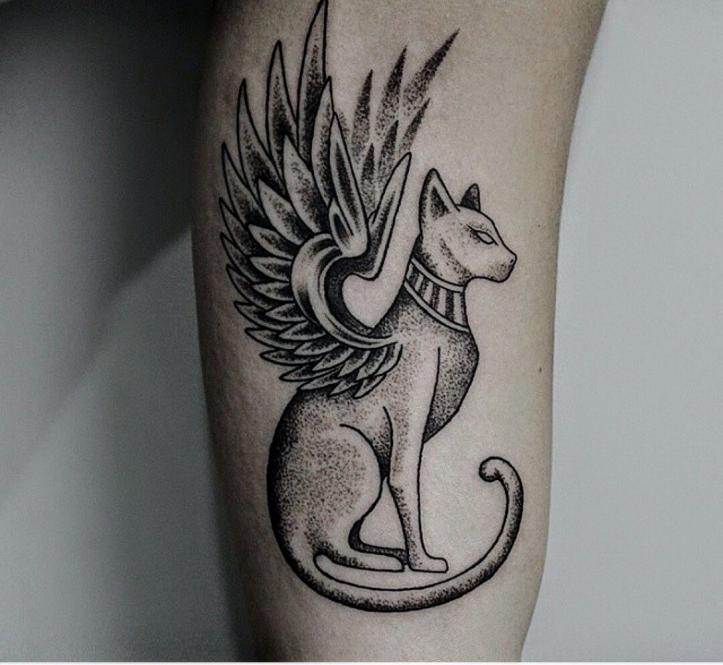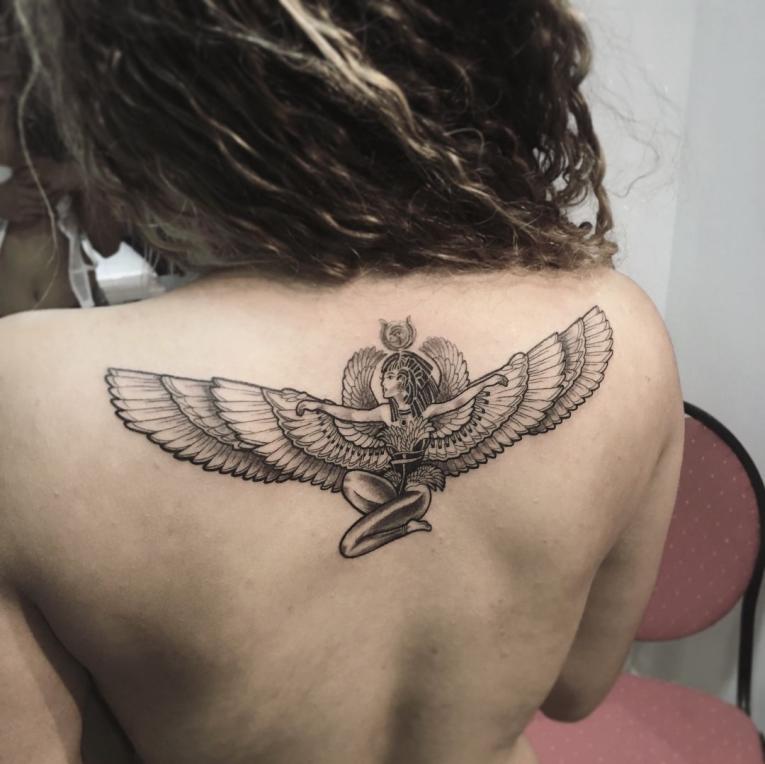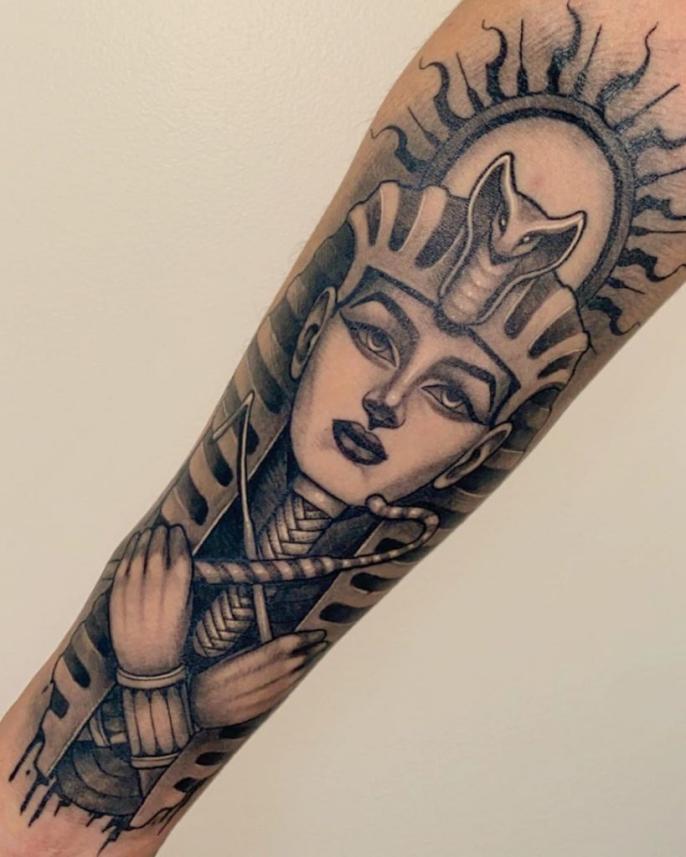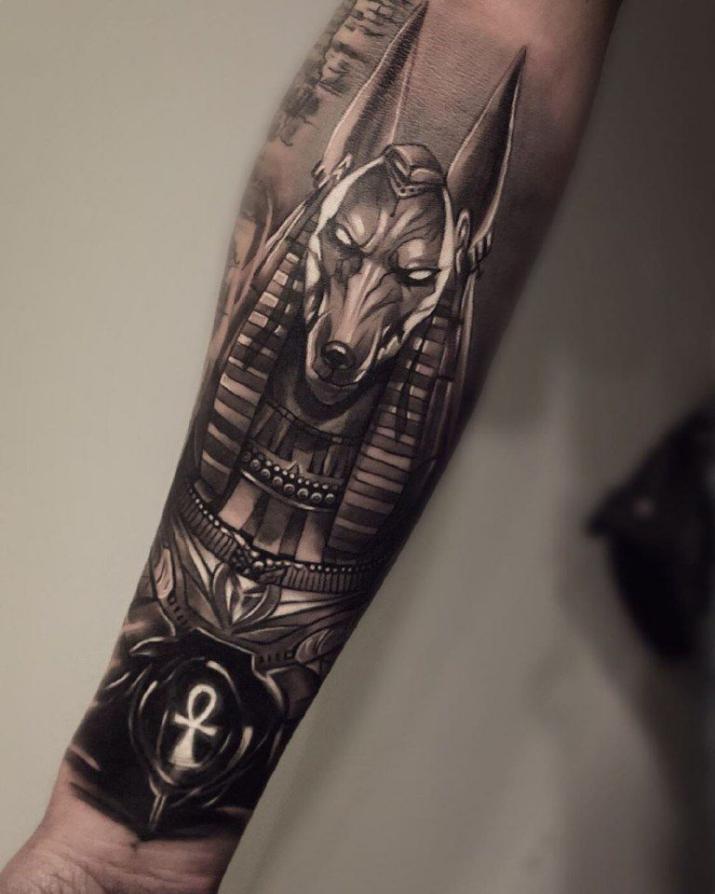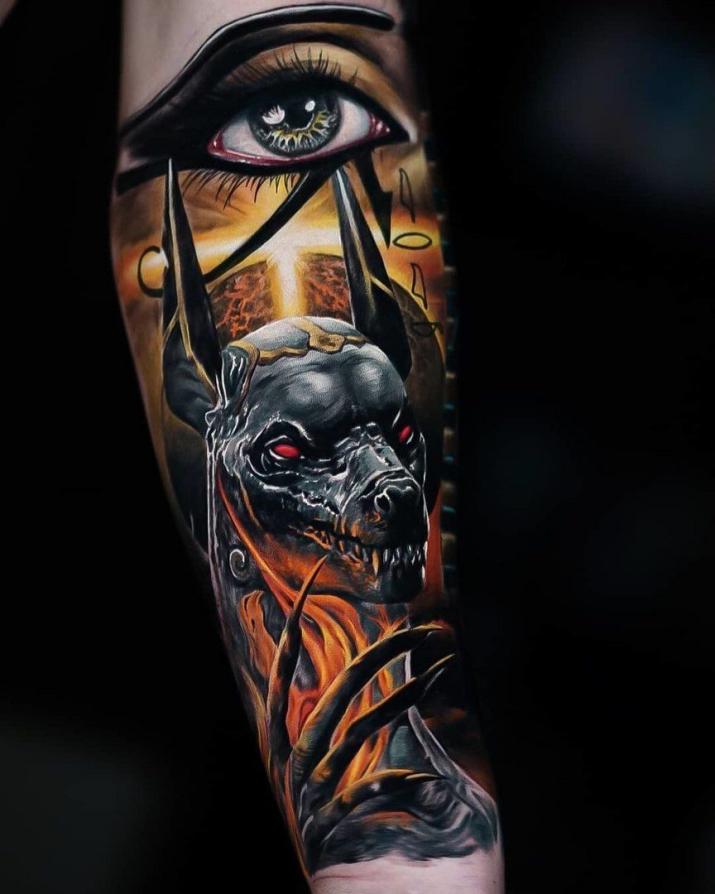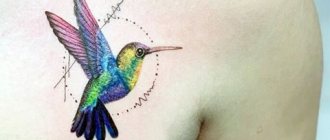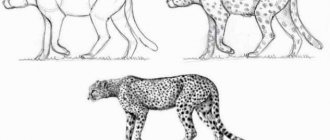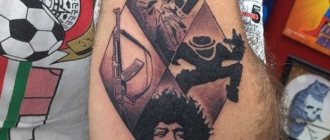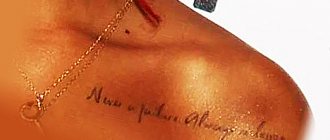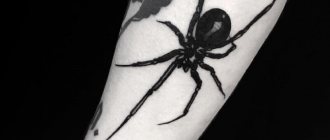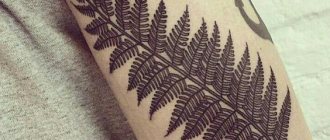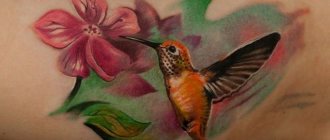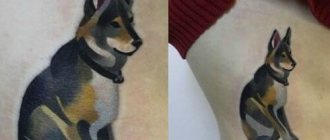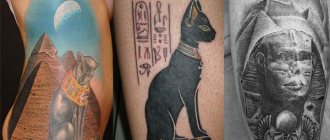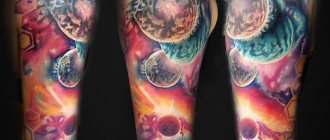Egyptian tattoos amulets: meaning of basic + connection with the afterlife + protective tattoo for mother and child + quick healing + aspects of human behavior before and after the protective tattoo + real life example.
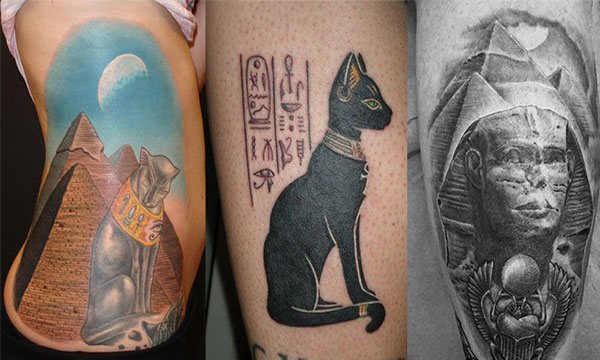
Egyptian amulets applied to areas of the body protect a person from adversity, negative outside energy, enemies and their evil intent.
The tattoo is able to attract good luck, happiness and fortune to its owner. The first images in ancient Egypt were dots and lines drawn on the body, depicting the flow of energy to bring vitality.
History of the symbol
The tattoo with Bastet refers to a historical image of an ancient deity, whose mystical meaning is reinforced by legends of findings in millennial tombs of pharaohs and their inexplicable effects on humans. The cat in ancient Egypt was considered a sacred animal endowed with extraordinary abilities. It was worshipped, looked upon as a protector from evil forces, after its death there was mourning in the home. Tattoo with a depiction of the Egyptian cat could afford to apply the priests of the goddess Bastet or wealthy people endowed with power.
For girls
Women are not so inclined to do various tattoos (tattoo), including symbols of deities of ancient religions. This is due to the fact that the representatives of the weaker sex are more reverent about their appearance. But emancipation has changed their attitude.
If a modern woman wears a drawing of Anubis on her body, it means that she has an enviable determination, is not afraid of the difficulties of life and to some extent inclined to fatalism.
The meaning of the tattoo is the same as for men, but it should be remembered that the tattoo was qualitative (the smallest details of the figure are visible), it will have to sacrifice a large section of your skin. The figure of Anubis symbolizes wisdom, calculation and calmness.
Meaning
Tattoo Egyptian cat, the meaning of which is multifaceted, as well as the essence of the animal itself, can be reduced to the following characteristics:
- gracefulness, gracefulness, beauty;
- haughtiness, willfulness, impregnability;
- cunning, cunning, slyness;
- prudence, sociability, friendliness;
- affectionate, sympathetic, active;
- nobility, independence;
- Family happiness - the goddess Bast is the guardian of the family home.
The image of the cat can be found in all myths and cultures of the world. So the goddess Freya of Scandinavia keeps them in a harness that supernaturally protects her, the peoples of the East see them as good and wealthy. Buddhists saw the animal as protection for temples. Europe of the Middle Ages invested in them a mystical meaning, on this basis there was a mass extermination of cats, the result of which was the infestation of rats and plague epidemics. Indeed - the secret unknown meaning and the physical reality are united together.
What do you need to know when applying Egyptian tattoo amulets?
Choosing a tattoo amulet to apply to the body, it is necessary to stop at one of them and decide why this particular artifact has attracted the attention of the future owner. To do this, the masters advise to adhere to the following conditions:
- Having become interested in some way, it is necessary to study all the information about its origin, protective properties.
- Egyptian tattoos are conditioned by many small, but very important details that must be taken into account.
- If white spots are found during the selection, Egyptologists should be consulted to clarify them.
- When applying the image, you should take into account its location on the body part.
- Before visiting the studio or salon it is not advisable to drink alcohol, use antibiotics. Also not allowed to come ill or weak.
- Before the start of the session you should have a good sleep, have breakfast and take a restorative shower.
Unprofessionally made tattoo amulet will become, at best, a usual picture, at worst - will bring a lot of trouble and misfortune. Mankind has not yet learned the secrets of Egyptian artifacts.
Slavic amulets runes: 4 varieties
Styles and variants of sketches
Most often, tattoos with a reference to ancient Egypt are performed in the style of realismWhen the lines, texture and subject matter have like a living outline. The image of a cat or the goddess herself in a human body, at the same time she can sit on a throne. Sometimes a tattoo fulfills an entire storyline. For example, a sacrifice in honor of a goddess or a moment of worship in a temple.
This style is characterized by natural colors and an intricate manner of execution. Not all masters of tattoos work with this direction because of the peculiarity and complexity of the drawings.
For girls and women is more suitable style blackwork tattoo (or in the English equivalent black work). The technique works with silhouettes made only in black colors. The sketch can be complemented by various decorations and elements that will later stand out in color. This can be a musical instrument sistr, jewelry (earrings, necklace, gemstones), and eye color. The eyes are usually preferred to draw cat eyes, but there are also sketches where the goddess has human eyes.
Where to place?
Choosing the right place for a tattoo is as important as choosing a sketch. In this case. the so-called individual pain threshold should be taken into account. If there is no confidence to endure pain in certain areas of the body, then this issue should be discussed with the master of the tattoo.
The larger the size of the tattoo, the more area on the skin it will occupy. If you pick up a place not on the size of the figure, the details may layered on top of each other, as the distance between them will have to be reduced. In addition, the end result is likely to be not as beautiful as one would like it to be: it will simply merge into one incomprehensible spot.
Most often girls choose places on the wrists hands, where small tattoos with a minimal amount of color can fit. This can be minimalism or blackwork.
Legs - An ideal option for padding large and voluminous tattoos. You can draw on the shin or thigh. Do not tattoo near the knee, as this place is very painful for tattoos.
Shoulders The shoulders are very popular places to put a tattoo. Both large and small designs can be placed on the shoulder.
The shoulder blades and ribs are considered painful, but if you do not have too sensitive skin, you can safely choose them for padding the figure.
Back - is a large area where you can put an entire painting. But you should choose the place wisely. And also to think whether there is a need for a tattoo on the entire back, especially - for women.
You should always remember about your body type, especially in those cases, when you score a tattoo on the forearm, thighs or lower leg. Tattoo because of sharp weight gain or, on the contrary, weight loss can be deformed.
Nabivate or not?
The Egyptian theme attracts both young and mature people regardless of social status and profession. Some tattoos carry sacred or occult meaning. Usually these tattoos are done on the arm or around the shoulder.
History and mythology have been closely intertwined with tattooing from ancient times. However, the drawings were not always considered in a certain narrow context.
Even in the modern world, the meaning of Egyptian tattoos cannot be interpreted unequivocally. These mysterious symbols are controversial among both historians and art historians. Some consider the application of such signs as a protest against world religions - Christianity and Islam. Others believe that Egyptian tattoos can attract luck and good fortune and protect people from hardship, enemies and malice.
Beautiful examples
A tattoo of the goddess Bastet inscribed on her ribs. Performed by in the blackwork style. Used black as the base color and white for highlighting.
Example of a tattoo in minimalist style. A cat is depicted in profile. Her whole body is done in black, but the details are depicted in color.
Example of a tattoo In the new skool style. There is a certain cartoonishness in the image. Soft features and outline.
Tattoos with mythical creatures, signs, gods from ancient pantheons can be seen quite often. What could be more symbolic than the image of an ancient deity?
Interest in the culture of ancient Egypt has not waned since the first discoveries were made in millennia-old tombs. Legends of deadly curses, the magical powers of the priests, the countless treasures hidden in the tombs of the pharaohs only strengthen this interest.
Today we will talk about the goddess Bastet, the tattoo of her image and its symbolism.
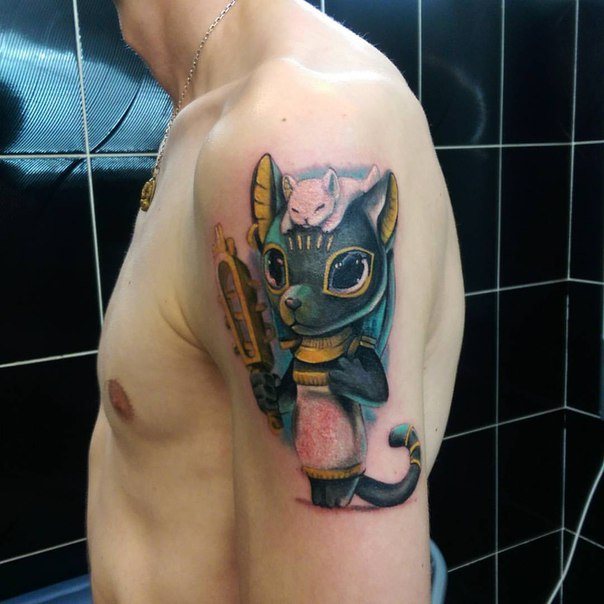

The origins of the beliefs of the ancient Egyptians
The life of the peoples in the Nile Delta depended on the forces of nature: the flooding river provided a fertile layer of soil, the sun could both warm its rays and burn the heat of the crops, wild beasts regularly attacked livestock and sometimes people. Gradually, the elements and their power became personified, that is, they took on the features of intelligent beings. This is how the first gods in the ancient Egyptian pantheon appeared.
At the same time, the doctrine of the soul, which, according to the ancient Egyptians, consisted of 9 parts, was developing. To provide the parts of the soul with a comfortable transition to the afterlife and a happy life after death, the Egyptians created a complex of special funeral rituals. The most famous of them is mummification, i.e. preservation of the body with the help of embalming agents and layers of cloth.
In all, there were about 700 deities in the pantheon of the peoples of ancient Egypt, but many of them had only local significance. The key characters of the mythology were about 20, the most significant of which we will discuss below.
Sun God Ra
Ra is the creator god and head of the pantheon, the fighter against the armies of darkness. The Egyptian sun god is depicted as a human figure with the head of a falcon or falcon - that's how Ra is drawn and on the tattoo sketches. The sun god is also known as Amon Ra. Amon is the deity of light among the people of Thebes. As is often the case, the two cults merged into one, and Ancient Egypt received a deity with a double name. In tattoo designs, the image of the god Ra is often given the significance of the victory of light over darkness, but this is not necessary: you can score yourself a tattoo just because you liked this character.
The Great Cat Goddess
The fact that the ancient Egyptians considered cats to be sacred animals will not be news even to those who have never seriously interested in the culture of this people. A man who accidentally ran over a cat with a chariot was publicly stoned to death; when a cat died in a house, the owners shaved off their eyebrows as a sign of mourning. Such traditions serve as proof of the worship of these graceful and willful animals.
The goddess Bastet was portrayed as a cat or a woman with a cat's head, usually holding a sistr, a traditional musical instrument.
What does the image of Bastet promise to its owner?
Based on the beliefs of the ancient Egyptians, the meaning of the tattoo Bastet boils down to the following:
- Love Who does not dream of sincere mutual love? For the ancient Egyptians, the main reason for marriage was love, which is not the case with many other peoples. Of course, in high society were widespread and marriages of convenience, but they are often found now, so do not assume that the concept of marriage in the ancient Egyptians were so different from ours. The tattoo of the goddess Bastet is a talisman that helps in the search for true love.
- Fertility. In ancient times, when mortality from disease and war was much higher than now, high fertility was extremely important. Representatives of every nation believed that a large number of children in the family was the highest good, and the Egyptians were no exception.
- Family happiness. Bastet is the helpmate of the keepers of the home. A tattoo with her image is often chosen by women who value family above all else. Perhaps the owner of the tattoo has already created a happy family and now spares no effort to constantly surround her relatives with love and care. Maybe, for now, she only dreams of meeting a man who will give her this happiness. Tattoo of the Egyptian goddess Bastet can become an amulet designed to help her find it.


Bastet in the art of tattooing
Bastet is the patroness of women, so tattoos with her image are mainly chosen by the fair sex. Most often the cat goddess is painted on the shoulder, forearm, back or chest.
One of the most successful styles for this tattoo - realism. This style usually depicts traditional figures of the goddess. You can also see realistic cats in Egyptian jewelry. By the way, the Bastet cat tattoo is much more common than women with a cat head. Works that copy ancient frescoes look authentic, but surprisingly they are less popular.
Many depict Bastet in the form of a kitten, such tattoos look very cute, reminiscent of cartoon characters. In this way, the artist uses a new-school style, which is bright and emotional enough to convey the cheerfulness that carries the image of Bastet.
The works with the cat goddess are supplemented with decorative elements; she's wearing a lot of gold ornaments with precious stones. Sometimes she is depicted together with other gods of the Egyptian pantheon, most often with Anubis, against the background of the pyramids, frescoes in ancient tombs.
Tattoos with Bastet are always original, because they occur quite rarely. This image is endowed with grace and elegance, femininity and cheerfulness, so the image of Bastet can be considered a certain talisman, attracting only the best in the life of its owner.
